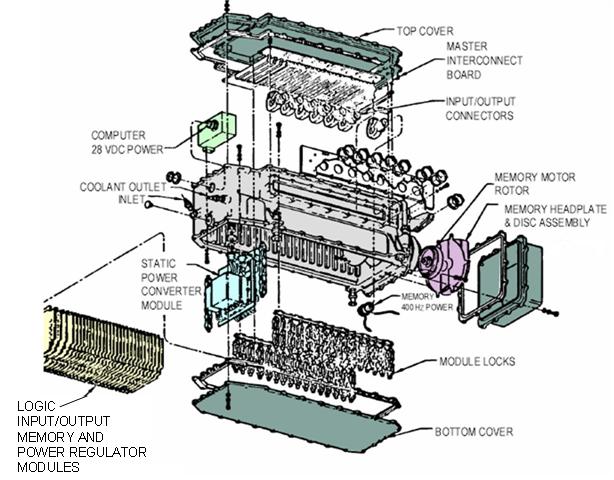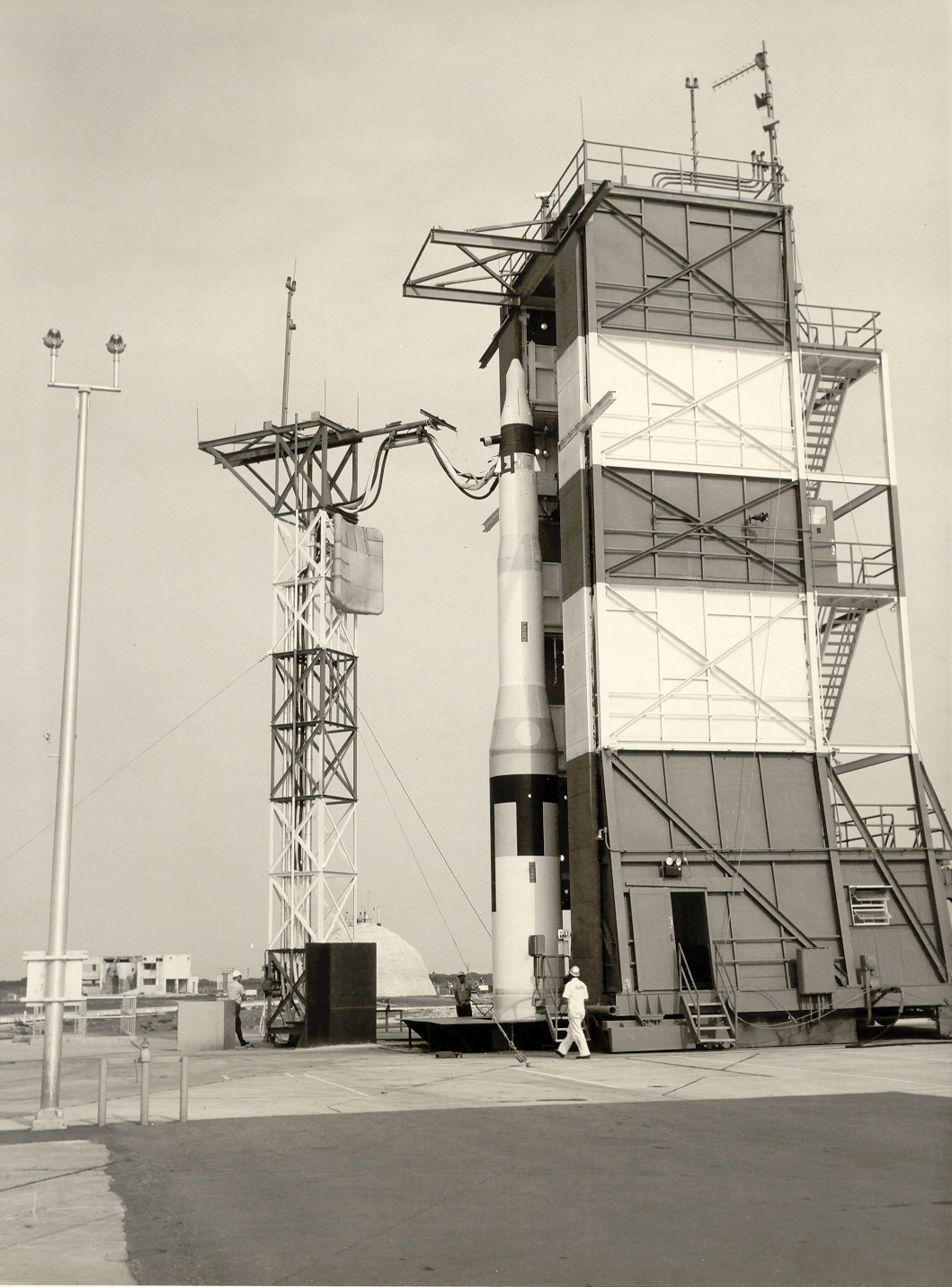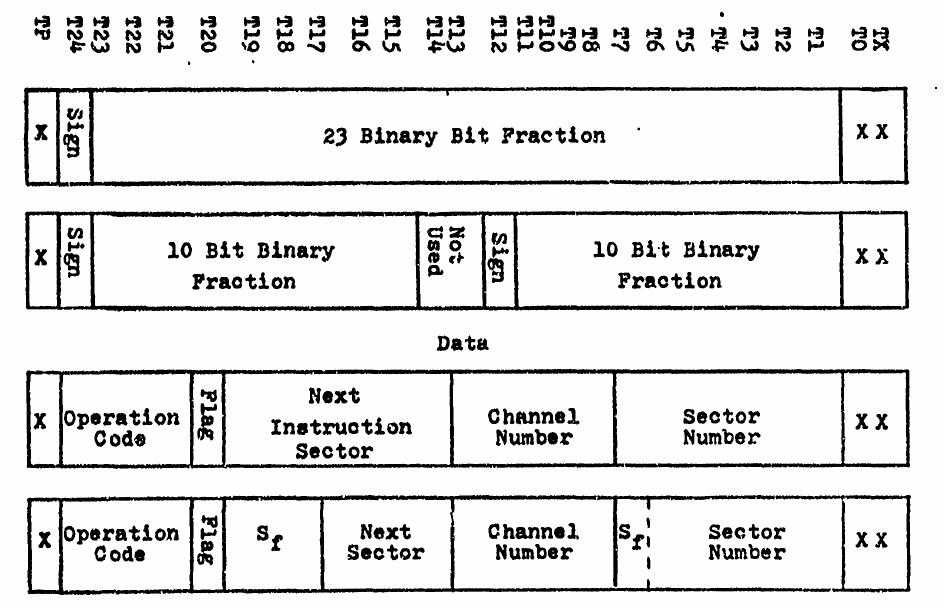|
D37D
{{Short description, Military flight computer The D37D Minuteman III flight computer was initially supplied with the LGM-30G missile, as part of the NS-20 navigation system. The NS-20 D37D flight computer is a miniaturized general purpose (serial transmission) digital computer. The new NS-50 missile guidance computer (MGC) is built around a 16-bit high-speed microprocessor chip set. They are both designed to solve real-time positional error problems under the adverse conditions encountered in airborne weapon systems. They accept and process data and generate steering signals with sufficient accuracy and speed to meet the requirements of the inertial guidance and flight control systems of the Minuteman ICBMs. Computer operation is controlled by an internally stored program which is loaded from a magnetic tape cartridge at the launch facility (LF). Both the D37D computer and the MGC are designed and programmed to control the Minuteman III missile throughout the powered portion of fli ... [...More Info...] [...Related Items...] OR: [Wikipedia] [Google] [Baidu] |
Minuteman III
The LGM-30 Minuteman is an American land-based intercontinental ballistic missile (ICBM) in service with the Air Force Global Strike Command. , the LGM-30G Minuteman III version is the only land-based ICBM in service in the United States and represents the land leg of the U.S. nuclear triad, along with the Trident submarine-launched ballistic missile (SLBM) and nuclear weapons carried by long-range strategic bombers. Development of the Minuteman began in the mid-1950s when basic research indicated that a solid-fuel rocket motor could stand ready to launch for long periods of time, in contrast to liquid-fueled rockets that required fueling before launch and so might be destroyed in a surprise attack. The missile was named for the colonial minutemen of the American Revolutionary War, who could be ready to fight on short notice. The Minuteman entered service in 1962 as a deterrence weapon that could hit Soviet cities with a second strike and countervalue counterattack if the U.S. ... [...More Info...] [...Related Items...] OR: [Wikipedia] [Google] [Baidu] |
Autonetics
Autonetics was a division of North American Aviation that produced various avionics but is best known for their inertial navigation systems used in submarines and intercontinental ballistic missiles. Its 188-acre facility in Anaheim, California, with 36,000 employees, was the city's largest employer. Through a series of mergers, Autonetics is now part of Boeing. Origin Autonetics originated in North American Aviation's Technical Research Laboratory, a small unit in the Los Angeles Division's engineering department, in 1945. In 1946, the laboratory won an Army Air Forces contract to develop a 175 to 500 mile range glide missile. The work and the lab expanded, and by June 1948, all of the Aerophysics Laboratory was consolidated at Downey, California. The evolution of the Navaho missile program then resulted in the establishment of Autonetics as a separate division of North American Aviation in 1955, first located in Downey, moving to Anaheim, California in 1963. Divisions Autonetics ... [...More Info...] [...Related Items...] OR: [Wikipedia] [Google] [Baidu] |
D-37C
The D-37C (D37C) is the computer component of the all-inertial NS-17 Missile Guidance Set (MGS) for accurately navigating to its target thousands of miles away. The NS-17 MGS was used in the Minuteman II (LGM-30F) ICBM. The MGS, originally designed and produced by the Autonetics Division of North American Aviation, could store multiple preprogrammed targets in its internal memory. Unlike other methods of navigation, inertial guidance does not rely on observations of land positions or the stars, radio or radar signals, or any other information from outside the vehicle. Instead, the inertial navigator provides the guidance information using gyroscopes that indicate direction and accelerometer An accelerometer is a tool that measures proper acceleration. Proper acceleration is the acceleration (the rate of change of velocity) of a body in its own instantaneous rest frame; this is different from coordinate acceleration, which is acc ...s that measure changes in speed and direc ... [...More Info...] [...Related Items...] OR: [Wikipedia] [Google] [Baidu] |
D-17B
The D-17B (D17B) computer was used in the Minuteman I NS-1OQ missile guidance system. The complete guidance system contained a D-17B computer, the associated stable platform, and power supplies. The D-17B weighed approximately , contained 1,521 transistors, 6,282 diodes, 1,116 capacitors, and 504 resistors. These components were mounted on double copper-clad, engraved, gold-plated, glass fiber laminate circuit boards. There were 75 of these circuit boards and each one was coated with a flexible polyurethane compound for moisture and vibration protection. The high degree of reliability and ruggedness of the computer were driven by the strict requirements of the weapons system. Design constraints High reliability was required of the D-17B. It controlled a key weapon that would have just one chance to execute its mission. Reliability of the D-17B was achieved through the use of solid-state electronics and a relatively simple design. Simpler DRL (diode–resistor) logic was used ex ... [...More Info...] [...Related Items...] OR: [Wikipedia] [Google] [Baidu] |
Minuteman Guidance Computer (1)
Minutemen were members of the organized New England colonial militia companies trained in weaponry, tactics, and military strategies during the American Revolutionary War. They were known for being ready at a minute's notice, hence the name. Minutemen provided a highly mobile, rapidly deployed force that enabled the colonies to respond immediately to military threats. They were an evolution from the prior colonial rapid-response units. The minutemen were among the first to fight in the American Revolution. Their teams constituted about a quarter of the entire militia. They were generally younger, more mobile, and provided with weapons and arms by the local governments. They were still part of the overall militia regimental organizations in the New England Colonies. The term has also been applied to various later United States civilian paramilitary forces. History In the colony of Massachusetts Bay, all able-bodied men between the ages of 16 and 60 were required to particip ... [...More Info...] [...Related Items...] OR: [Wikipedia] [Google] [Baidu] |
Minuteman III D37D
Minutemen were members of the organized New England colonial militia companies trained in weaponry, tactics, and military strategies during the American Revolutionary War. They were known for being ready at a minute's notice, hence the name. Minutemen provided a highly mobile, rapidly deployed force that enabled the colonies to respond immediately to military threats. They were an evolution from the prior colonial rapid-response units. The minutemen were among the first to fight in the American Revolution. Their teams constituted about a quarter of the entire militia. They were generally younger, more mobile, and provided with weapons and arms by the local governments. They were still part of the overall militia regimental organizations in the New England Colonies. The term has also been applied to various later United States civilian paramilitary forces. History In the colony of Massachusetts Bay, all able-bodied men between the ages of 16 and 60 were required to participa ... [...More Info...] [...Related Items...] OR: [Wikipedia] [Google] [Baidu] |
Missile Guidance
Missile guidance refers to a variety of methods of guiding a missile or a guided bomb to its intended target. The missile's target accuracy is a critical factor for its effectiveness. Guidance systems improve missile accuracy by improving its Probability of Guidance (Pg). These guidance technologies can generally be divided up into a number of categories, with the broadest categories being "active", "passive", and "preset" guidance. Missiles and guided bombs generally use similar types of guidance system, the difference between the two being that missiles are powered by an onboard engine, whereas guided bombs rely on the speed and height of the launch aircraft for propulsion. History The concept of unmanned guidance originated at least as early as World War I, with the idea of remotely guiding an airplane bomb onto a target, such as the systems developed for the R.F.C. World War I Drone Weapons, first powered drones by Archibald Low (The Father of Radio Guidance). In World War ... [...More Info...] [...Related Items...] OR: [Wikipedia] [Google] [Baidu] |
Military Computers
This article specifically addresses U.S. armed forces military computers and their use. History Some of the earliest computers were military computers. Military requirements for portability and ruggedness led to some of the earliest transistorized computers, such as the 1958 AN/USQ-17, the 1959 AN/MYK-1 ( MOBIDIC), the 1960 M18 FADAC, and the 1962 D-17B; the earliest integrated-circuit based computer, the 1964 D-37C; as well as one of the earliest laptop computers, the 1982 Grid Compass. Military requirements for a computer small enough to fit through a submarine's hatch led to the AN/UYK-1. Construction Typically a military computer is much more robust than an industrial computer enclosure. Most electronics will be protected with a layer of conformal coating. There will be more structure inside to support the components, the plug-in cards will be individually supported and secured to assure they do not pop out of their sockets, the processor and heat sink will be secured, m ... [...More Info...] [...Related Items...] OR: [Wikipedia] [Google] [Baidu] |





.jpg)